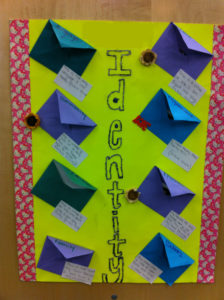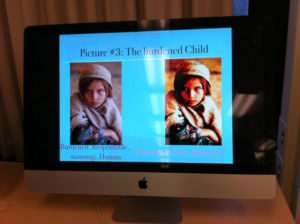Sports for the Mind: How do you bring Connected Learning into the Classroom?
November 4, 2013
PROJECTS: Leveling Up
TAGS: ChicagoQuest, Connected Learning, Design, Digital Media & Learning
Ugochi Acholonu is a postdoctoral scholar for the Connected Learning Research Network looking at ways that formal learning environments can be adapted to support Connected Learning. Junaidullah Khan is a teacher at ChicagoQuest (a public charter school) implementing curriculum to support connected learning in his classroom. In this post they combine their perspectives to think about the theoretical and practical aspects of changing formal institutions to facilitate connected learning.
Connected Learning: Relevance, the 4th R from DML Research Hub on Vimeo.
The video above summarizes the Connected Learning vision. In the video, connected learning is characterized as a societal movement, where school is just one of the institutions that needs to be transformed. In the Connected Learning vision, “school” is converted from a specific building within a neighborhood, to an active coalition of museums, corporations, homes, online communities, and teen hangout groups that work together to provide sustained spaces for students to learn by authentically doing (i.e. performing actions that directly contribute and shape various communities). Although the video talks about Connected Learning in terms of changes to institutions, institutions only change through the actions of individuals. In this post, I shine a spotlight on a teacher who is taking actions to bring connected learning into his classroom. I ask him to share his thoughts on designing curriculum, the concerns and hopes he has for his students, and how the Connected Learning framework shapes his decisions.
Mr. Khan: The Sports for the Mind Teacher
Mr. Khan is a seasoned teacher, with seven years of teaching experience in both high school and middle school settings. He has taught courses ranging from American and world history, to geography and political science. Currently, Mr. Khan teaches a course called Sports for the Mind at ChicagoQuest. ChicagoQuest is a 6-9th grade middle school, that serves primarily African American and Latino students. Sports for the Mind is a class where students are introduced to theories and methods for innovation. The class engages students in system thinking, design thinking, and even game design.
In a typical class students are asked to view the world as a system of systems. A particular system, such as games, become the focus of a lesson. Students break the system, in this case a game, into its components (i.e., goals, parts, rules, core mechanics, and constraints), locate the system’s leverage points, and then they are asked to either break or adapt the system to reach a user-centered goal. The assignments are often project-based and require iteration. Sample projects are shown below.
Image 1: Student project on communicating meaning through graphic manipulation.
Image 2: Student project on the connection between music and social justice movements.

Image 3: Student Project on Identity. Prompt: What is your identity? Think of a way to share your identity with others.
In addition to introducing students to methods of innovation, Sports for the Mind is designed to engage students in critical digital literacies (e.g., computer programming, graphic design, and critical consumption of media). The engagement in critical literacies is a goal that is extremely important to Mr. Khan because many of his students do not have access to expensive technologies or the technical practices that make these tools powerful. As a result, he designs his course to use technology in a way that help students recognize the power of their voices.
When designing activities, the first and most important thing I consider is the value of the skills to the student. I think about how the activity will position students to engage with technology and what it means for learning in and outside of my classroom. Often times, the activities in Sports for the Mind are centered around an age-appropriate interest, e.g., games, fiction, and the like. However, the work itself and the tools that we use are constantly connected and reconnected to the empowerment value of the experience. The tool and activity have to work together to provide students with the ability to express and communicate something provocatively and professionally.
Sports for the Mind is a unique course. This uniqueness allows Mr. Khan the freedom to tailor the curricula to his students. However, uniqueness can also be a hindrance, especially when it comes to building student and parent buy-in. Students and parents have ideas around what school is “supposed” to be and what activities are beneficial for the future. Many of these perceptions of what is beneficial to students are based, as the video discusses, on old models of school-to-work pathways; thus reading, writing, and arithmetic seem more valuable than art, gardening, and a class like Sports for the Mind. On account of this difficulty, Mr. Khan often tries to frame activities so that students recognize the new technology and design skills they have gained, and how they can use those skills in the present to seek new opportunities. In fact, one of the biggest challenges that Mr. Khan faces in designing his course is changing students beliefs about themselves, especially what they are capable of doing.
My hope is that students learn that they can learn the technologies that, for most of our students, are new. The acceptance of the “can factor” is the most empowering element in this class. I want students to recognize the power they have, and use that potential to achieve their goals.
Sports for the Mind is ChicagoQuest’s systematic attempt to bring connected learning to their school environment and culture. Mr. Khan sees the Connected Learning framework of interest-driven, peer-supported, and academic-oriented as essential to supporting students’ creative processes.
The connected learning principles are absolutely essential to the way I design my course. When selecting different technologies and the associated activities, I deeply consider students’ interests (“interest powered”) and what will foster engagement. In my class, students are often collaborating and working in groups to complete projects; students are required to take part in feedback sessions in which their input sparks iteration or at the very least reflection on the work (“peer supported”). All projects in my class are meant to be “academically oriented” so as to keep in line with the fact that we operate within the school system. Students often utilize tools from Sports for the Mind in other classes to help enhance their work or just creatively communicate something to their audience.
Although Mr. Khan sees the synergy of the Connected Learning principles and the design of his course, I push him on the relevance and impact his class is having on the students, especially in light of the increased violence in Chicago. He gives me a very frank reply.
As of right now we have not addressed any Chicago issues outright. At this point, Sports for the Mind is still in it’s infancy. Currently, I am focused mostly on empowerment through access, access to tools and innovation practices that serve some communicative purpose. My personal feeling is that the true potential of Sports for the Mind has yet to be experienced. It almost feels like the class tools and direction can and should take a more serious and intentional route towards social justice issues both locally and globally. Only then will the teaching be internalized and truly empowering…That being said we have had projects that have addressed the issue of gun violence in Chicago and the greater United States. We have also examined the obesity crisis, as well as environmental sustainability and how it relates to our world.
Mr. Khan looks forward to learning more about the connected learning framework and what that means for designing curricula. As he alluded to earlier, he feels like there is more he should be doing to truly bring connected learning into his classroom. However, he finds it difficult to locate resources that help him create activities that are tailored to his students and allow his students to participate in diverse communities. But he continues to innovate.
As stated before, my hope is that this learning space can develop into an experience that not only gives students access to the latest tools, but empowers them to use the skills effectively. I want to provide students with information that helps direct students to different realities, realities they may have never even considered.
—Mr. Junaidullah Khan
REFERENCES
Tyack, D. B. (1995). Tinkering Towards Utopia: A Century of Public School Reform. Harvard University Press.





